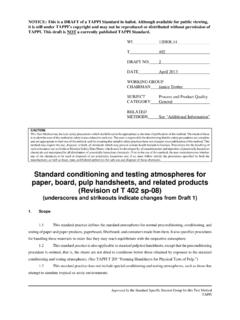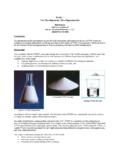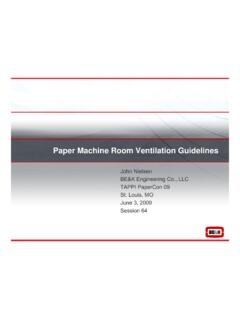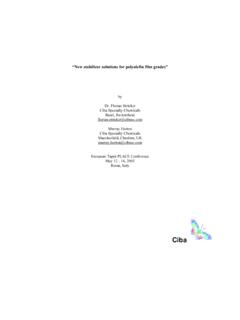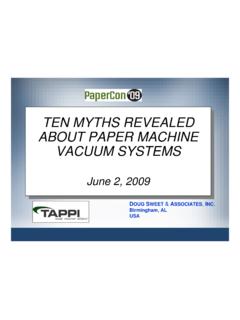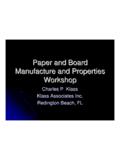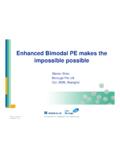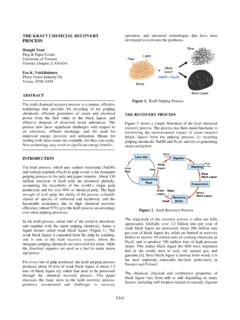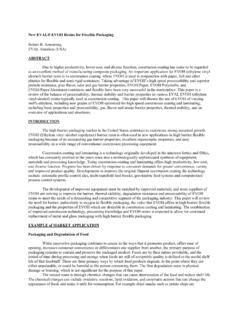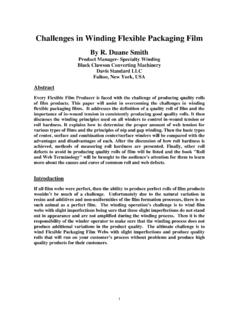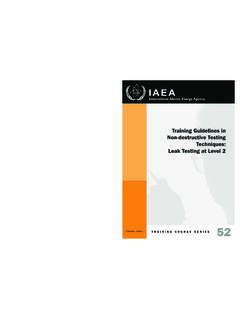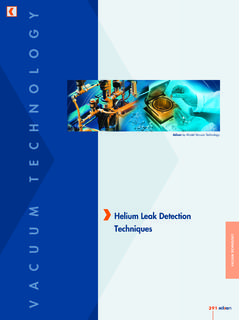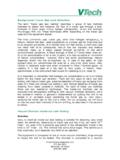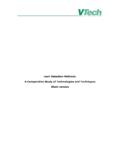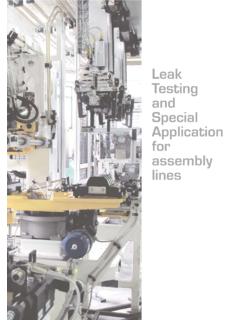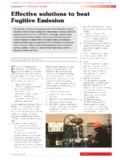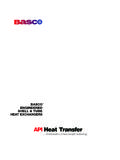Transcription of Methods for Testing High Barrier Materials - TAPPI
1 Methods FOR Testing high Barrier MATERIALSM ichael L. TroedelPresidentMAS Consulting Services16820 Highway 10 Suite 120 Elk River, MN 55330 ABSTRACT The permeation of packaging Materials has been of importance to packaging engineers, food scientists and materialengineers for decades. A brief history of permeation Testing Methods will be covered followed by a more detaileddescription of new emerging technologies and test Methods . Recent advances in patented flow technology, masstransfer analysis and understanding, high speed predictive computer analysis and low cell volume construction nowgive engineers and scientists the ability to determine material and flavor interactions, shelf life estimations, andrapid permeability, solubility and diffusion coefficient analysis.
2 This mass transfer analysis allows materialproducers, converters and end-users the ability to predict the performance of packaging Materials by not only usingpermeability, but also understanding the importance of solubility and diffusion on this performance. INTRODUCTIONH istorically, the measurement value of interest in the polymer, material or packaging industries has been thepermeation coefficient or transmission rate of a compound (typically, water vapor, oxygen, carbon dioxide or otherorganic vapors) in the steady state.
3 In the most general terms, Testing the permeation or Barrier properties of highbarrier Materials involves several basic steps, irregardless of the test gas or permeant. This involves inserting the testmaterial into some sort of test cell, closing and sealing the test cell, and then purging both sides of the test cell toestablish a baseline. Then the test gas, vapor or permeant is introduced onto one side of the test material ; as the gas,vapor or permeant begins to pass through the test material , it is "captured" on the opposite side of the test cell andcarried into some type of detector specific to the gas, vapor or permeant in question. Typically this will generate asteady state equilibrium curve similar to that shown in Figure VAPOR TRANSMISSION RATE TESTINGThe original standard for Testing water vapor transmission of high Barrier Materials is referred to in the industry as"the cup method".
4 This method involves placing a small sample of the test Materials over the top of a pre-mademetal cup. The cup may contain water, in which case, the water vapor would pass through the test material and thecup would lose weight over time. In this scenario, the cups are placed into a test chamber containing a desiccant todrive the water vapor through the test material and weighed at periodic intervals until equilibrium is obtained(constant weight loss). Alternatively, the cup may contain a desiccant, be placed in a test chamber with water vapor( high humidity); in this case, the moisture pick-up by the desiccant is weighed until equilibrium. These methodswere developed over many years and are now a standard ASTM Method (1).
5 The cup method has always hadseveral major shortcomings. It is a very tedious method and the results are very operator dependent. Secondly, it willtake a very long time to measure very high Barrier Materials as they will take a long time to come to equilibrium;furthermore, the results obtained on very high Barrier Materials may not be very the early 1970's, several companies tried to automate water vapor transmission rate Testing . Early in my career, Ioperated A Honeywell WVTR Tester. This machine contained a test chamber, where the test material was clampedinto a test cell with moisture on one side and a gold grid moisture detector on the other. The operator simply insertedthe sample, press the start button, which began the purge cycle, and then the machine automatically timed (inseconds) the amount of time it took for the moisture grid sensor to pick-up a pre-determined amount of time was then converted into a permeation rate.
6 This was a very easy, convenient test method that gave highlyvariable results. It was never approved as an ASTM was followed in the early 1970's by a method to measure WVTR of Flexible Barrier Materials Using anInfrared Detection Technique (2). This method also involved clamping the test material into a test chamber withmoist sponges on the outer chambers and an infrared photocell beam to detect the moisture in the central method did provide measurements in far less time and with better precision than the traditional cup method (3).In the mid-1980's, an improved infrared WVTR method was developed using a modulated infrared sensor (4). Oneof the big advantages of this method was its use of five samples in a "conditioning" position to help reduce time tosteady state the early 90's, MAS Technologies pioneered new patented mass transfer analysis Methods and a new device forthe measurement of high Barrier properties of films against gases.
7 This new device employed an extremely highsampling rate of permeant gas with little or no background noise, allowing detection sensitivity, which was greatlyenhanced relative to the previously referenced test Methods . This led to the development of a new enhanced ASTMM ethod for diffusivity, solubility, and permeability of water vapor (5). This new test procedure employs masstransfer analysis that allows for high speed computer prediction of the steady state equilibrium value by analyzingthe transient portion of the equilibrium curve; this has been used as a very valuable time saving technique especiallywhen Testing very high Barrier Materials with typically long equilibrium curves.
8 Furthermore, by using all of the datagenerated in the transient portion of the curve, the diffusion coefficient and the solubility coefficient are alsodetermined. With the analysis of this additional information, mass transfer applications such as shelf life predictions,compound absorption by food products, and loss of a compound from a food product into a packaging material (scalping) can be 2 is a diagram of the moisture diffusion apparatus referenced in this new test method. The cell used in thisapparatus (see figure 3) is a low volume, four zone test cell. The advantages of this test cell include multiplematerial analysis during a single test sequence, replicate material analysis during a single test, and increased samplearea and sensitivity.
9 This new apparatus allows for automated temperature and relative humidity profiling of asample material . This new method also allows for the traditional reference film calibration of the equipment or for amore accurate direct water injection procedure as used in calibrating gas (CARBON DIOXIDE, NITROGEN) TRANSMISSION RATE TESTINGIn the case of oxygen (and other similar test gases such as carbon dioxide, nitrogen, helium, etc.), the early standardwas the "Dow cell" method (7). This method contains two procedures; one is a manometric method and the other isa volumetric method. These Methods were very operator dependent; in fact, the precision statement in the methodsays "the precision of the results obtained depends strongly, but in an unpredictable manner, on the combination ofmaterial and gas being tested".
10 This equipment also required a very high level of maintenance to keep it method was largely replaced in the late 1970's by a method using a coulometric sensor (8). However, thismethod is only specific to oxygen and other test gases still had to use the older, more traditional Methods . Thediagram of the components used in this method is shown in Figure 4. The apparatus first developed for this methodused a single head test cell as shown Figure 4; later versions of this equipment included multiple test cells (up to 10).This method was a dramatic improvement over the traditional Dow cell method in that it was much more operatorfriendly, required a great deal less maintenance, and allowed the equilibrium curve to be graphically displayed as thetest progressed instead of calculating a single value at the end of the method will be supplemented by a new method for oxygen vapor Barrier measurement of flexible Materials ,which is currently being balloted within ASTM Subcommittee on Test Methods .
